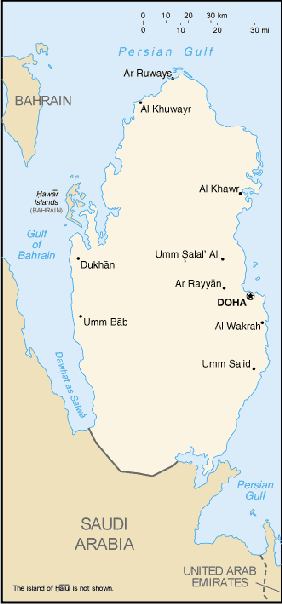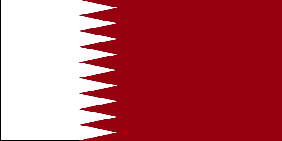
|

Qatar
Background:
Ruled by the Al Thani family since the mid-1800s, Qatar transformed itself from
a poor British protectorate noted mainly for pearling into an independent state
with significant oil and natural gas revenues. During the late 1980s and early
1990s, the Qatari economy was crippled by a continuous siphoning off of
petroleum revenues by the amir who had ruled the country since 1972. He was
overthrown by his son, the current Amir HAMAD bin Khalifa Al Thani, in a
bloodless coup in 1995. In 2001, Qatar resolved its longstanding border
disputes with both Bahrain and Saudi Arabia. Oil and natural gas revenues
enable Qatar to have a per capita income not far below the leading industrial
countries of Western Europe.
Location:
Middle East, peninsula bordering the Persian Gulf and Saudi Arabia
Area: Total: 11,437 sq km, water: 0 sq km, land: 11,437 sq km.
Area - comparative: Slightly smaller than Connecticut.
Land boundaries: Total: 60 km border countries: Saudi Arabia 60 km.
Coastline: 563 km.
Climate and Terrain:
Climate: Arid; mild, pleasant winters; very hot, humid summers.
Terrain: Mostly flat and barren desert covered with loose sand and gravel.
Elevation extremes: Lowest point: Persian Gulf 0 m, highest point: Qurayn Abu
al Bawl 103 m.
Natural resources: Petroleum, natural gas, fish.
People:
Population: 793,341.
Ethnic groups: Arab 40%, Pakistani 18%, Indian 18%, Iranian 10%, other 14%.
Religions: Muslim 95%.
Languages: Arabic (official), English commonly used as a second language.
Government:
Government type: Traditional monarchy
Capital: Doha.
Independence: 3 September 1971 (from UK).
Economy overview:
Oil accounts for more than 30% of GDP, roughly 80% of export earnings, and 58%
of government revenues. Proved oil reserves of 3.7 billion barrels should
ensure continued output at current levels for 23 years. Oil has given Qatar a
per capita GDP comparable to that of the leading West European industrial
countries. Qatar's proved reserves of natural gas exceed 7 trillion cubic
meters, more than 5% of the world total, third largest in the world. Production
and export of natural gas are becoming increasingly important. Long-term goals
feature the development of offshore natural gas reserves. In 2000, Qatar posted
its highest ever trade surplus of $7 billion, due mainly to high oil prices and
increased natural gas exports, and managed to maintain the surplus in 2001.
GDP - composition by sector: Agriculture: 1%, industry: 49%, services: 50%.
Statistics:
Telephones - main lines in use: 142,000.
Telephones - mobile cellular: 43,476.
Radio broadcast stations: AM 6, FM 5, shortwave 1.
Radios: 256,000.
Television broadcast stations: 1 (plus three repeaters).
Televisions: 230,000.
Internet users: 75,000.
Railways: 0 km.
Highways: Total: 1,230 km, paved: 1,107 km , unpaved: 123 km.
Airports: 4,
with paved runways: 2,
with unpaved runways: 2.
Heliports: 1.
Return to Visiting Locations
|

